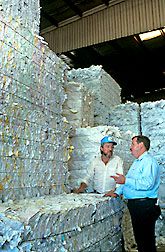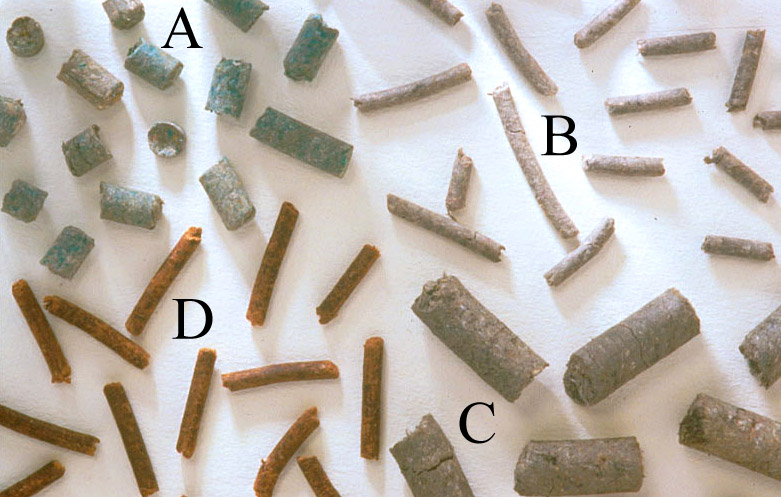 Don't Throw that
Out!
Don't Throw that
Out!
James Edwards, an ARS
soil scientist,
was a recycling machine. His specialty was
using different combinations of newspapers, telephone books, yard waste,
chicken litter (poop), and other kinds of paper and waste materials to grow
crops. This type of recycling is called composting.
Dr. Edwards, deceased, worked at ARS’ National Soil Dynamics Laboratory in Auburn, Alabama. Shortly before Dr. Edward's passing, Dr. Watts went to Alabama to check out the soil scientist's composting projects and quiz him on this subject.
Dr. Watts: How do you compost newspapers and phone books?
Dr. Edwards:
We mix the paper with chicken litter,
 waste from local cotton gins,
and refuse such as wallboards (seen in this picture). We had the phone books
shredded and plowed into the soil, so we could use it to grow corn, soybeans,
and cotton.
waste from local cotton gins,
and refuse such as wallboards (seen in this picture). We had the phone books
shredded and plowed into the soil, so we could use it to grow corn, soybeans,
and cotton.
Dr. Watts:Why use all this different stuff?
Dr. Edwards:This shows people how many things can be composted. No matter where you live, you can find something. We used mixed solid wastes from farms, cities, and small towns.
Dr. Watts: Why recycle? Or compost?
Dr.
Edwards: Most of the trash is taken to
 landfills and sometimes property owners have to pay to
take their trash to landfills. In some states it costs $17 a ton. Landfills are
closing in some states because of strict and costly environmental
regulations.
landfills and sometimes property owners have to pay to
take their trash to landfills. In some states it costs $17 a ton. Landfills are
closing in some states because of strict and costly environmental
regulations.
Here’s a quick question for you. How much paper do Americans throw away each day?
 Trash or
Treasure
Trash or
Treasure
So, before you throw out the trash, see what you can recycle. Some companies even pay for phone books, newspapers and aluminum. Does your school have a recycling program? If not, why don’t you and some classmates talk to your teacher about starting one?
 “Yesterday’s newspaper or
even last year’s telephone directories could turn up again,” Edwards
said. He worked with manufacturers and others to process newspapers, phone
books, and other types of waste paper into a shredded product or pellets.
“Yesterday’s newspaper or
even last year’s telephone directories could turn up again,” Edwards
said. He worked with manufacturers and others to process newspapers, phone
books, and other types of waste paper into a shredded product or pellets.
Gardeners can
spread the paper by hand or mix it in the soil. Here are some ways it can be
used:

A)
Medium pellets developed as testing
material.
B)
Small pellets for landscape mulch.
C) Large pellets for erosion control.
D) Small pellets with pigment added for more attractive
landscape mulch.
![]() Does this stuff work? Edwards tested shredded
newspaper and telephone books on corn, soybeans, cotton, tomatoes, collards,
and other vegetables. Guess what happened when he mixed in
compacted soil? The
paper loosened the soil and improved yields of corn soybeans and cotton.
Does this stuff work? Edwards tested shredded
newspaper and telephone books on corn, soybeans, cotton, tomatoes, collards,
and other vegetables. Guess what happened when he mixed in
compacted soil? The
paper loosened the soil and improved yields of corn soybeans and cotton.
It’s good for chickens,
too.
![]() The paper pellets form a soft
bedding that is easier on baby chick’s bodies and feet than aged sawdust
or other stuff typically used in poultry houses. Farmers said they like the
bedding better and that it does a better job of absorbing urine and ammonia
fumes. “These pellets fluff up when they get wet and absorb 4 to 5 times
their weight in water,” Edwards said.
The paper pellets form a soft
bedding that is easier on baby chick’s bodies and feet than aged sawdust
or other stuff typically used in poultry houses. Farmers said they like the
bedding better and that it does a better job of absorbing urine and ammonia
fumes. “These pellets fluff up when they get wet and absorb 4 to 5 times
their weight in water,” Edwards said.
More Recycle Info...
ARS’ Beltsville Agricultural Research Center built a 2-acre, 77,000 square-foot composting center. It mainly handles manure and other wastes such as potting soil and plants. They have an area set aside for research to find out which blends of materials make the best compost. The compost material will be used for other ARS projects.
—By Tara Weaver-Missick, Agricultural Research Service

ARS' National Soil Dynamics Laboratory